Original Draconian Laws may be Revealed by New Machine

Much of what ancient scribes carved in stone is lost to weathering. Among the hard-to-read are tablets from Draco, a rather severe politician who codified the laws of ancient Athens.
A new technique promises to reveal these and other stone scribblings using X-rays.
Scientists figure there are at least half a million Greek and Latin inscriptions on stones in various states of decay and legibility.
"Because of the information contained in them, they are invaluable sources for the historian, archaeologist, art historian and every student of institutions and life in the ancient world," said Kevin Clinton, a Cornell University professor of classics and co-author of a new paper on the technique.
Cornell researchers developed a process called X-ray fluorescence (XRF) imaging to recover faded text on stone by "zapping and mapping" the inscriptions.
The group built a machine that generates X-rays a million times more intense than what the doctor uses to image your bones. An X-ray beam is fired at a stone, scanning back and forth. Atoms on the stone's surface emit lower-energy fluorescent X-rays, and different wavelength emissions reveal zinc, iron and other elements in the stone.
Historians know that iron chisels were commonly used to inscribe stone, and the letters were usually painted with pigments containing metal oxides and sulfides. So where letters and numbers are no longer visible to the eye, the newfound minerals trace their shapes.
Sign up for the Live Science daily newsletter now
Get the world’s most fascinating discoveries delivered straight to your inbox.
Tests conducted on stone tablets a hundred generations old clearly reveal writing that was lost to the eye.
The study of incised writing on stone and other surfaces is called epigraphy.
"This means restoring thousands of stones, including, possibly, part of the law code of Draco," Clinton said. "It applies to practically any kind of public document you can think of, including many laws, decrees, religious dedications and financial documents."
You've heard Draco's name referred to in phrases starting with "Draconian." He didn't make up the laws, but he was the first to get them written down. Back then, minor offenses carried the death penalty, and debt was a road to slavery.
"X-ray fluorescence imaging has the potential to become a major tool in epigraphy." said Robert Thorne, Cornell professor of physics. "It's just so much more powerful than anything that's been used in the past."
The technique will be detailed in the German journal Papyrology and Epigraphy.
Earlier this year, scientists said they were using a particle accelerator to reveal writings of the Greek mathematician Archimedes.
Robert is an independent health and science journalist and writer based in Phoenix, Arizona. He is a former editor-in-chief of Live Science with over 20 years of experience as a reporter and editor. He has worked on websites such as Space.com and Tom's Guide, and is a contributor on Medium, covering how we age and how to optimize the mind and body through time. He has a journalism degree from Humboldt State University in California.










